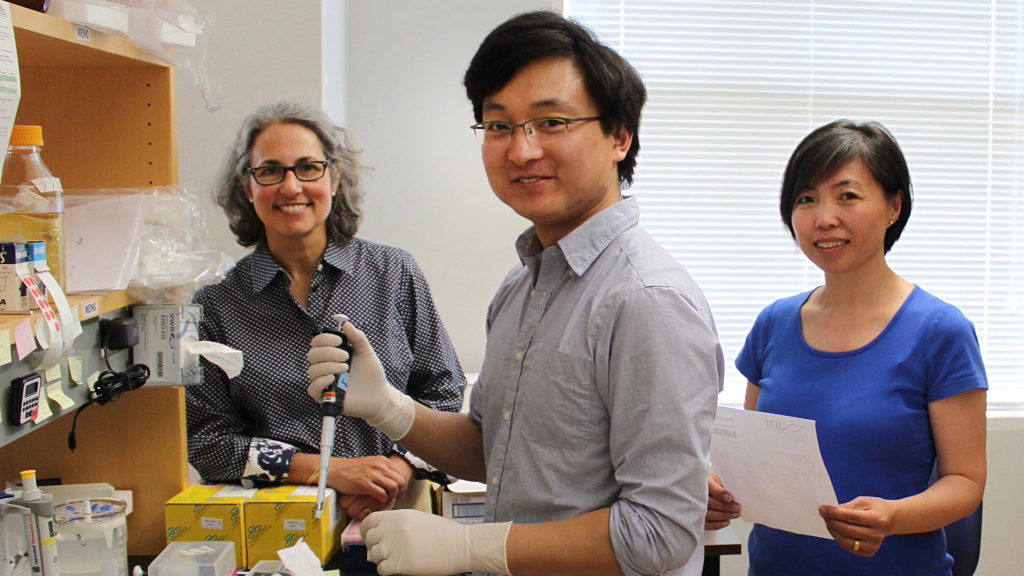FRAXA Research Grants Drive Big Investments in Fragile X

I recently sat down with Dr. Mike Tranfaglia, Medical Director and Chief Science Officer at FRAXA Research Foundation to find out what he’s been up to. Many of our donors probably don’t know about the tremendous amount of work Mike does behind the scenes.
The past year has seen a remarkable transformation in the Fragile X research field, according to Mike. Many new clinical trials are beginning, many new pharmaceutical companies are entering the arena, and advances in technology are changing the way research is done. All of these developments are extraordinarily positive, and they mean that enhanced treatments for Fragile X are on the way.
Most people know that FRAXA supports academic research at many institutions such as Harvard University, University of Pennsylvania, Massachusetts Institute of Technology, and Yale University. However, FRAXA is also working with almost 30 pharmaceutical companies around the world. Mike spends a lot of his time advising and collaborating with industry partners. His work has helped bring more companies into the field of Fragile X research, which brings more resources and new ideas into play. He also helps identify gaps in research and acts as a broker to connect different organizations to form collaborations.
Millions Could be Invested in Fragile X Research
One example is a UK-based company, Autifony Therapeutics. Dr. Leonard Kaczmarek, a long-time FRAXA-supported researcher at Yale, introduced Mike to the CEO of Autifony, Dr. Charles Large. One of their compounds, AUT00206, is being developed to treat schizophrenia. Autifony worked with Mike to test this compound for potential use to treat Fragile X. At the FRAXA Drug Validation Initiative (FRAXA-DVI), tests of this compound in our Fragile X mice showed positive results, indicating AUT00206 may be useful to treat Fragile X. This data helped Autifony forge a collaboration with a large pharmaceutical company, Boehringer Ingelheim. They will pay Autifony a €25 million upfront fee, with the possibility of further payments of up to €17.5 million during the option period, based on achievement of short-term milestones. The total potential transaction may sum up to €627.5 million (773,111,375 US dollars!) upon reaching development and pre-commercialization milestones if Boehringer Ingelheim exercises its option. This could bring enormous financial resources to Fragile X research!
FRAXA Support Opens Doors to Funding from Additional Sources
Mike also visited the University of Wisconsin recently, leading a discussion on gene reactivation with a team of scientists including previous FRAXA grantees Dr. Xinyu Zhao and Dr. Anita Bhattacharyya. They are combining their expertise to find ways to reactivate the Fragile X gene. While previous researchers have conducted studies on mice, our team used human stem cells to draw more accurate conclusions about potential Fragile X treatments. Using a new genetic editing tool, they inserted a “reporter gene” allowing them to identify when new drugs succeed in reactivating the gene that causes Fragile X syndrome. Dr. Zhao also transplanted stem cells into mouse brains to more effectively study brain development and drug treatment.
Early FRAXA support of these scientists led to a large grant from the John Merck Fund ($1 million over 4 years), showing once again how FRAXA support opens doors to funding from additional sources. The Zhao and Bhattacharyya lab teams are continuing this work at Wisconsin, using it as a test-bed in their own efforts to find drugs that reactivate FMR1. Mike also introduced these researchers to another FRAXA partner, Fulcrum Therapeutics, which is using gene reactivation in its drug development.
Progress on Effective Treatments in Fragile X Mice
Back in FRAXA’s home town of Newburyport, MA, leaders of another pharmaceutical company, Seropeutics, met with Mike to discuss their product concepts and the potential rationale for targeting some of the symptoms of Fragile X. Mike had several meetings with Executive Chairman and CEO Donald R. Kiepert and Dr. Raymond Booth, Scientific Founder and Chief Scientist, to help guide their strategy. The lead from their first platform, SERx–519, is directed at the core Fragile X symptoms that occur in most patients (repetitive behaviors, social deficits, anxiety, cognitive dysfunction); and their second platform candidate, SERx–480, is focused on the other symptoms that appear frequently in Fragile X syndrome (attention deficit, hyperactivity, psychosis/mania). Both platforms target brain serotonin receptors, an area of intense research over the last two decades.
Incidentally, FRAXA also supports Dr. Clinton Canal, a former postdoc in Dr. Booth’s lab. Dr. Canal left Northeastern to start his own lab at Mercer University. His project is examining the function and the numbers of serotonin receptors of various subtypes (of which there are many!) in the brains of FMR1 knockout mice (so-called Fragile X mice that are missing the same neuroprotein that is missing in Fragile X patients). Recent results from Dr. Canal’s laboratory indicate Seropeutics’ SERx–519 drug candidate is effective and apparently safe to prevent sound-induced seizures in Fragile X mice. Seizures are reported in about 20% of males (less for females) with Fragile X syndrome. While the preclinical effects of SERx–519 on seizures in Fragile X mice bodes well for Fragile X patients who experience seizures, the general effectiveness of SERx–519 to treat symptoms associated with missing FMR1 neuroprotein provides optimism that the drug’s beneficial effects may translate to treatment of core Fragile X symptoms such as repetitive behaviors, social deficits, anxiety, and cognitive dysfunction.
More to Come
As you can see, Mike is very busy opening new doors and helping bring more resources to Fragile X research. These are just a few examples, but there are many more exciting things happening behind the scenes. Stay tuned!
